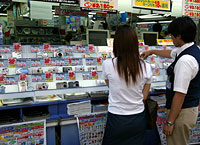|
|
|||||||
|
|
|||||||
|
|||||||
| | Web Japan >> | Trends in Japan >> | Business & Economy >> | Digital Century | |
|
DIGITAL CENTURY New Services Fuel Digicam Growth (April 11, 2003) Consumers are snapping up digital cameras in ever-increasing numbers as prices fall, picture quality improves, and new features like powerful zoom lenses and video are added. Photo labs offering digital photo printing and a growing variety of net-based services are expanding the range of ways in which digicam owners use their cameras. Domestic shipments of digital cameras overtook those of film cameras two years ago, and some 8 million digicams are expected to be sold in 2003. A product that was seen as a mere PC peripheral when it first hit the shelves has become a must-have item in its own right.
A Market of 8 Million and Counting The hottest selling digicams are compact, carry-anywhere models. Consumers have taken a particular shine to light, ultracompact cameras that are small enough to fit into a shirt pocket and weigh only about 90 grams. These models generally boast picture quality in the one-megapixel (one million pixels) range, which is quite sufficient for everyday snaps and close-range shooting, and retail for around ¥25,000 to ¥30,000 ($208 to $250 at ¥120 to the dollar). Another popular class is the mid-range three-megapixel digicam. A 5 inch x 3 inch print taken with a camera in this class is indistinguishable from one taken with a standard film camera. Each of the main manufacturers' mid-range models sells for around ¥40,000 to ¥50,000 ($333 to $417), a drop of about ¥20,000 since these cameras hit the market just over a year ago. Industry sources report that until 2002 most people bought digital cameras as accessories for their computers, but more and more consumers are now buying them to use independently of their PCs. This shift has been underpinned by the growing ease with which users can print photos taken with digicams onto paper just like those taken with traditional film cameras, with the result that sales of printers to which digital cameras can be connected directly are rising rapidly. According to the Camera and Imaging Products Association, in 2000 shipments of film cameras were still greater than those of digital cameras, but in 2001 film-camera shipments fell by 16% to 3.02 million, while digicam shipments shot up 64% to 4.83 million. In 2002 this gap widened as 2.24 million film cameras were shipped compared with 6.55 million digicams, and in 2003 the digicam dominance is predicted to increase further to 7.69 million versus 1.76 million.
Per-Pixel Prices Down by 90% in Eight Years Technological advances are yielding better and better image quality, and top-of-the-range 5 megapixel cameras are currently fulfilling consumers' desires for crystal-clear pictures. These models are currently somewhat expensive at ¥60,000 to ¥70,000 ($500 to $583), but once prices come down to the ¥50,000 range, consumers are sure to snap them up in greater numbers. The technology that enables features like zoom and movie shooting is also advancing rapidly. Many digicams can now shoot 30 or 60 minutes of video footage, with some even allowing 90 minutes. These models are beginning to make inroads into the video-camera market. Consumers can now choose from a wider range of options for printing the digital images they take. Those who demand the very best picture quality take their image data to photo labs for printing or order prints over the Internet by sending the data to online labs. Each 5 x 3 print at these labs costs about ¥35 to ¥50 ($0.29 to $0.42). It is also possible to print digital images as stickers and to exchange and view them online. And recently more and more stores have been installing unmanned printing machines that enable people to print photos taken with their camera-equipped mobile phones. The cameras attached to these phones are also producing better and better pictures, with models offering one-megapixel-plus digicam-standard images expected to hit the market soon. When this happens, competition between camera phones and digital cameras will heat up, heralding an exciting new era in the imaging devices market. Related Web SitesBic Camera (site is Japanese only) the Camera and Imaging Products Association Casio Computer Co. Copyright (c) 2004 Web Japan. Edited by Japan Echo Inc. based on domestic Japanese news sources. Articles presented here are offered for reference purposes and do not necessarily represent the policy or views of the Japanese Government. |
BRIGHT FUTURE (August 6, 2003) IT STARTED AS A PHONE (July 17, 2003) JAPAN'S HOMEGROWN OPERATING SYSTEM (May 22, 2003) |
|
|



